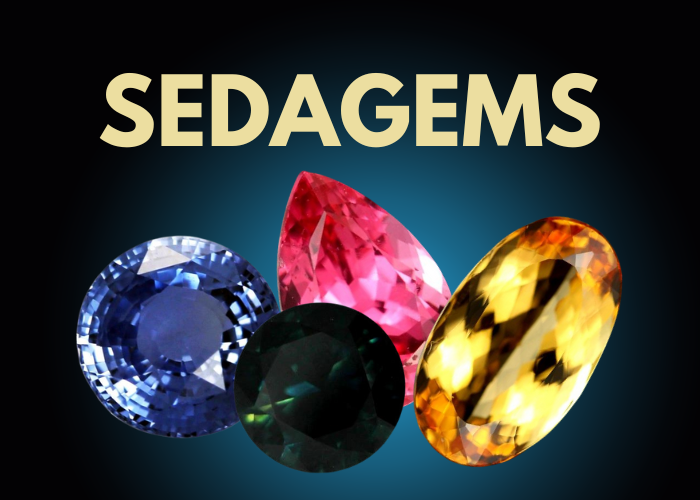Vous n'avez pas enchéri sur cette enchère.
10.20 CTS ALEXANDRITE - SPECIMEN FROM TANZANIA [STS2249]
- UGS
- Dimensions (mm)
- 12.000 x 9.000 x 9.000mm
- Poids (cts)
- 10.200
- Taper
- Specimen
- Couleurs
-
ALEXANDRITE SPECIMEN
This is a natural untreated Alexandrite specimen from Tanzania which i bought from the miner on my last trip there. They are not suitable for faceting but can be cabbed or kept as a specimen.
The most sensational feature about this stone, however, is its surprising ability to change its colour. Green or bluish-green in daylight, alexandrite turns a soft shade of red, purplish-red or raspberry red in incandescent light. This unique optical characteristic makes it one of the most valuable gemstones of all, especially in fine qualities.
Alexandrite is very scarce: this is due to its chemical composition. It is basically a chrysoberyl, a mineral consisting of colourless or yellow transparent chrysoberyl, chrysoberyl cat’s eye and colour-changing alexandrite (also in cat’s eye varieties). It differs from other chrysoberyls in that it not only contains iron and titanium, but also chromium as a major impurity. And it is this very element which accounts for the spectacular colour change. Rarely, vanadium may also play a part. According to CIBJO nomenclature, only chrysoberyls displaying a distinct change of colour may be termed alexandrite.
Like many other gemstones, alexandrite emerged millions of years ago in a metamorphic environment. But unlike many others, its formation required specific geological conditions. The chemical elements beryllium (a major constituent in chrysoberyl) and chromium (the colouring agent in alexandrite) have contrasting chemical characteristics and do not as a rule occur together, usually being found in contrasting rock types. Not only has Nature brought these contrasting rock types into contact with each other, but a lack of the chemical element silica (the second most common element in the Earth's crust) is also required to prevent the growth of emerald. This geological scenario has occurred only rarely in the Earth's history and, as a result, alexandrite crystals are very scarce indeed.
- UGS
- Dimensions (mm)
- 12.000 x 9.000 x 9.000 mm
- Poids (cts)
- 10.200
- Taper
- Specimen
- Couleurs
-
ALEXANDRITE SPECIMEN
This is a natural untreated Alexandrite specimen from Tanzania which i bought from the miner on my last trip there. They are not suitable for faceting but can be cabbed or kept as a specimen.
The most sensational feature about this stone, however, is its surprising ability to change its colour. Green or bluish-green in daylight, alexandrite turns a soft shade of red, purplish-red or raspberry red in incandescent light. This unique optical characteristic makes it one of the most valuable gemstones of all, especially in fine qualities.
Alexandrite is very scarce: this is due to its chemical composition. It is basically a chrysoberyl, a mineral consisting of colourless or yellow transparent chrysoberyl, chrysoberyl cat’s eye and colour-changing alexandrite (also in cat’s eye varieties). It differs from other chrysoberyls in that it not only contains iron and titanium, but also chromium as a major impurity. And it is this very element which accounts for the spectacular colour change. Rarely, vanadium may also play a part. According to CIBJO nomenclature, only chrysoberyls displaying a distinct change of colour may be termed alexandrite.
Like many other gemstones, alexandrite emerged millions of years ago in a metamorphic environment. But unlike many others, its formation required specific geological conditions. The chemical elements beryllium (a major constituent in chrysoberyl) and chromium (the colouring agent in alexandrite) have contrasting chemical characteristics and do not as a rule occur together, usually being found in contrasting rock types. Not only has Nature brought these contrasting rock types into contact with each other, but a lack of the chemical element silica (the second most common element in the Earth's crust) is also required to prevent the growth of emerald. This geological scenario has occurred only rarely in the Earth's history and, as a result, alexandrite crystals are very scarce indeed.
| Fournisseur d'expédition | Expédition vers :pays | Expédition dans le reste du monde |
|---|---|---|
| FedEx | $12.00 / : jours jours | $39.00 / : jours jours |
|
:pays
:fournisseur bénéficie d'une réduction de :prix sur les commandes avec :quantité ou plus d'articles
Reste du monde
:fournisseur bénéficie d'une réduction de :prix sur les commandes avec :quantité ou plus d'articles
|
||
| Registered Shipping | $9.00 / : jours jours | $16.00 / : jours jours |
|
:pays
:fournisseur bénéficie d'une réduction de :prix sur les commandes avec :quantité ou plus d'articles
Reste du monde
:fournisseur bénéficie d'une réduction de :prix sur les commandes avec :quantité ou plus d'articles
|
||

-
 Positif
PositifPaid and shipped - no feedback left after 100 days
-
 Positif
PositifBeautiful agate piece , and as always fast efficient service from Sedagems
-
 Positif
PositifNice
-
 Positif
PositifGorgeous stones, very happy
-
 Positif
PositifGorgeous stone, very happy
Pourquoi les utilisateurs se surenchérissent-ils ?
Lorsqu'une enchère est placée, il s'agit du montant maximum qu'un utilisateur est prêt à enchérir pour le produit. Notre système enchérira ensuite automatiquement au nom de cet utilisateur, augmentant progressivement l'enchère pour maintenir sa position d'enchérisseur le plus élevé, jusqu'au maximum spécifié.
Lorsqu'il y a une icône indiquant "Enchère automatique", cela signifie que notre système place activement des enchères pour l'utilisateur en fonction de son enchère maximale. Cela peut donner l'impression que les utilisateurs surenchérissent eux-mêmes, mais c'est simplement le résultat de la mise à jour de l'enchère par le système pour refléter la limite maximale des utilisateurs.











![22.9CTS VARASCITE 'SPIDER WEB' AUSTRALIA [MGW 4616]](https://liveplatforms-production.b-cdn.net/tenants/gr/uploads/images/490000-494999/490866/55236df10a48f.JPG?width=480&aspect_ratio=1001%3A1000)





